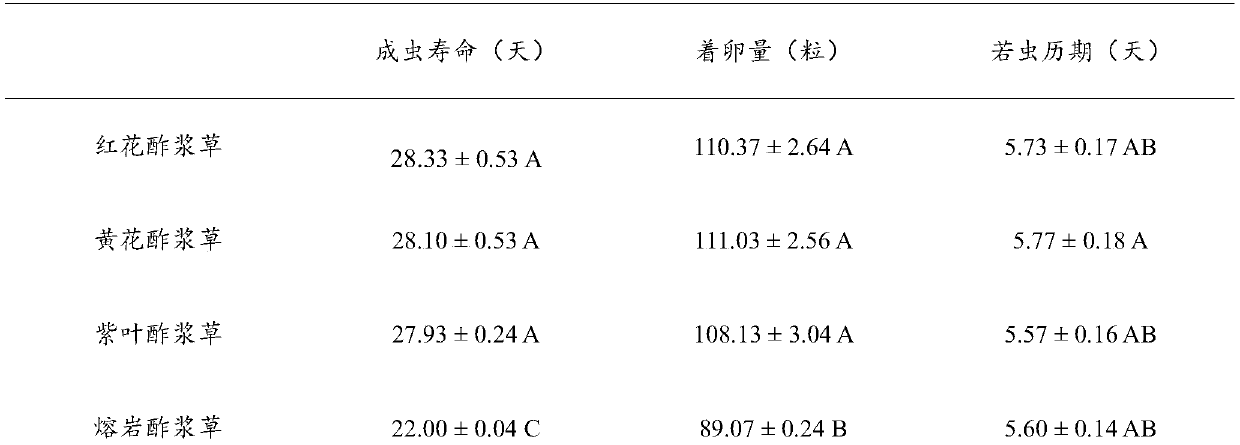Method for controlling tetranychus cinnabarinus
A red spider and plant technology, applied in the field of red spider prevention and control, can solve problems such as difficult to achieve results, environmental pollution, air pollution, etc., and achieve the effects of reduced amount, excellent trapping effect, and best prevention and control effect.
- Summary
- Abstract
- Description
- Claims
- Application Information
AI Technical Summary
Problems solved by technology
Method used
Image
Examples
Embodiment 1
[0024] During the peak period of red spider occurrence, the damage of red spiders to Rosaceae, Compositae, Malvaceae, Oxalidaceae and Cactus were investigated and compared respectively. The results are shown in Table 1. During the active period of red spiders, other The severity of occurrence on sorrel was higher than that of other susceptible species.
[0025] Table 1 Comparison of damage degree of spider mite on different seedling plants
[0026]
[0027]
[0028] Ⅰ—the leaves have no obvious changes;
[0029] Ⅱ—Small yellowish-white to off-white spots appear from both sides of the main vein of the petiole on the back of the leaf;
[0030] Ⅲ—The leaves turn pale gray, and the leaves turn yellow and lose green;
[0031] Ⅳ—The leaves are scorched and fall off, the plants are short and grow slowly.
[0032] In order to further confirm the wood sorrel strains preferred by red spiders, through indoor experiments (temperature 25-30°C, humidity 70-75%, light L:D=14:10), 12...
Embodiment 2
[0043] Under indoor conditions (temperature 25-30°C, humidity 70-75%, light L:D=14:10), on each pot of rose (pot diameter: 25.0cm; plant height: 30.0-40.0cm), connect the 50 red spiders, 20 pots of plants were arranged in a row, a total of 5 rows, and one of the three kinds of wood sorrel (red flower, yellow flower and purple leaf) was used as the trapping plant, and the surrounding type, strip type and There are 3 chessboard layout methods, set the distance from the rose 0m (docking), 0.5m, 1.0m, 1.5m and 2.0m, and replace the new ones on the 2nd, 4th, 6th, 8th and 10th days respectively Potted wood sorrel, and surveyed the total number of potted red spiders. The results are shown in Table 4. There was no significant difference in the number of red spiders under the surround, strip and checkerboard layouts. However, in actual operation, the strip type is simpler than the other two layouts, and requires fewer trapping plants. Therefore, a striped layout may be preferred. Un...
Embodiment 3
[0056] Insert 1000 red spiders on 5 pots of rose potted plants, insert 100, 40, 20, 10 and 5 Chinese lacewings respectively (the ratio of benefit to harm is 1:10, 1:25, 1:50 respectively , 1:100 and 1:200), after 24 hours, the number of remaining red spiders was counted, and the predation efficiency of Chinese lacewings on red spiders was studied. The results are shown in Table 7. The number of remaining red spiders decreased continuously with the increase of the number of Chinese lacewings. When the benefit-damage ratio of Chinese lacewings and red spiders was 1:50, the number of remaining red spiders reached the minimum value. The number of lacewings increased, but the number of red spiders did not decrease significantly.
[0057] Table 7 Effects of different benefit-to-damage ratios on the control efficiency of Chinese lacewing
[0058]
[0059]
[0060] Note: The values in the table are mean ± standard error, and different capital letters indicate significant diff...
PUM
 Login to View More
Login to View More Abstract
Description
Claims
Application Information
 Login to View More
Login to View More - Generate Ideas
- Intellectual Property
- Life Sciences
- Materials
- Tech Scout
- Unparalleled Data Quality
- Higher Quality Content
- 60% Fewer Hallucinations
Browse by: Latest US Patents, China's latest patents, Technical Efficacy Thesaurus, Application Domain, Technology Topic, Popular Technical Reports.
© 2025 PatSnap. All rights reserved.Legal|Privacy policy|Modern Slavery Act Transparency Statement|Sitemap|About US| Contact US: help@patsnap.com



